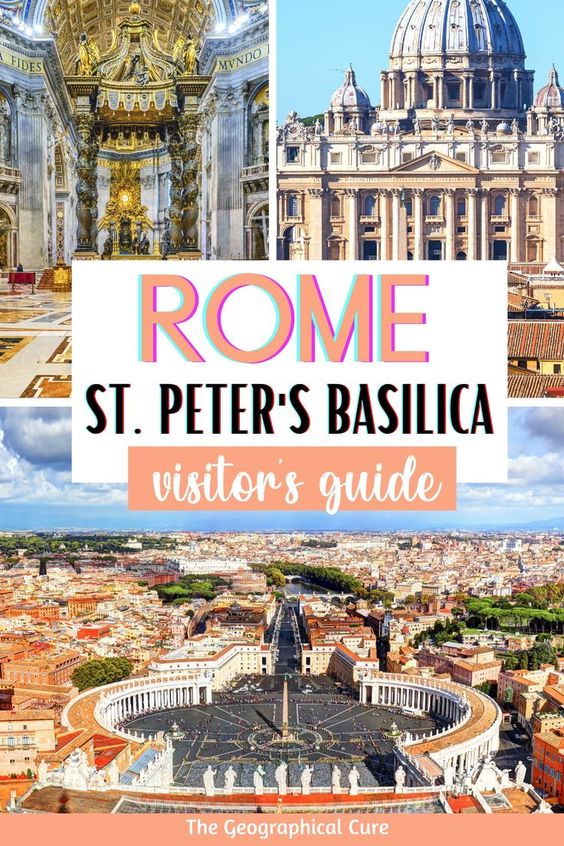St. Peter’s Basilica is the most famous church in Christendom. Designed by Bramante, Raphael, and Michelangelo, it’s a true Renaissance masterpiece.
It may be the most ornate space you’ve ever stepped foot inside, filled with an intense visual array of precious treasures and grandiose decoration.
St. Peter’s Basilica was completed after 120+ years of construction, the reign of 18 different popes, incalculable cost, and the direction of 12 different architects. Measuring more than two football fields in length, it’s by far the largest church in Christendom.
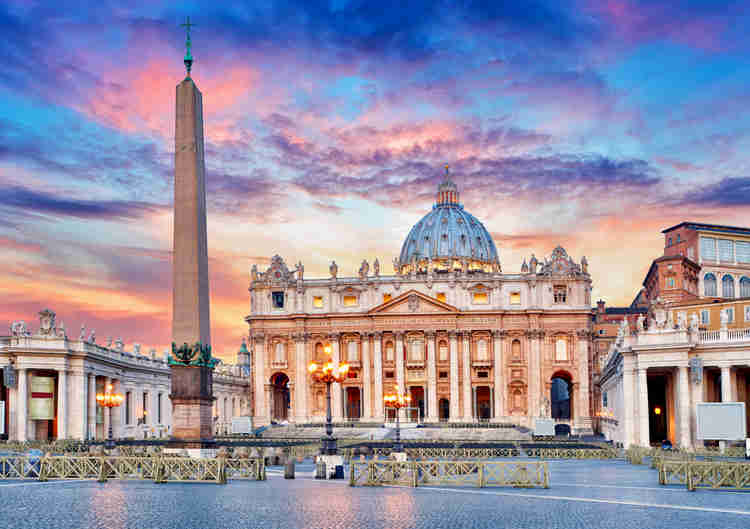
the stunning Basilica of St. Peter’s
The dome of St. Peters, with input from the revered Michelangelo, is the tallest in the entire world.
The basilica is the burial place of Saint Peter and past popes. This is where you’ll find the famous Bernini Baldachin canopy and Michelangelo’s tragically beautiful Pieta.
In this St. Peter’s guide, I identify the top 20 things to see at Italy’s most famous church. I also give you important must know tips for visiting this most important landmark.
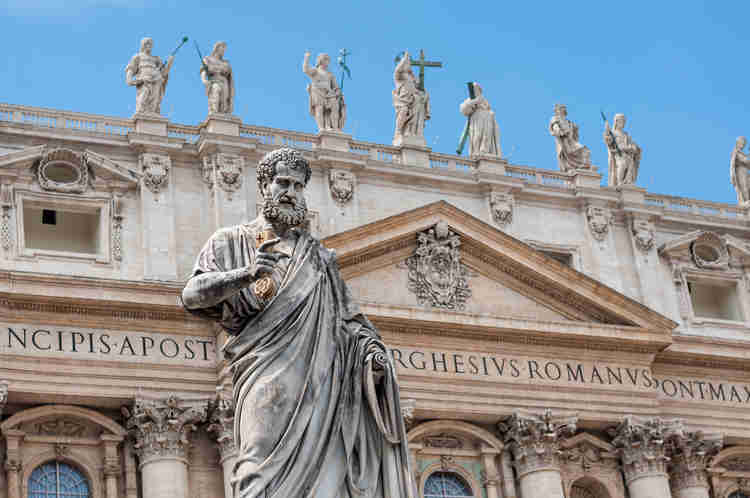
the statue of St. Peter in front of the facade of the basilica
Guide To St. Peter’s Basilica: What To See
St. Peter’s Basilica is absolutely crammed with amazing art.
To see everything, you may want to book a guided tour of the basilica. Or, book a guided tour that includes the basilica, a dome climb, and the underground grottos.
Alternatively, you can just purchase an audio guide and visit on your own.
With so many treasures of Western art to absorb, what should you be sure to see at St. Peter’s? Here’s my list of the highlights and best things to see in St. Peter’s Basilica:
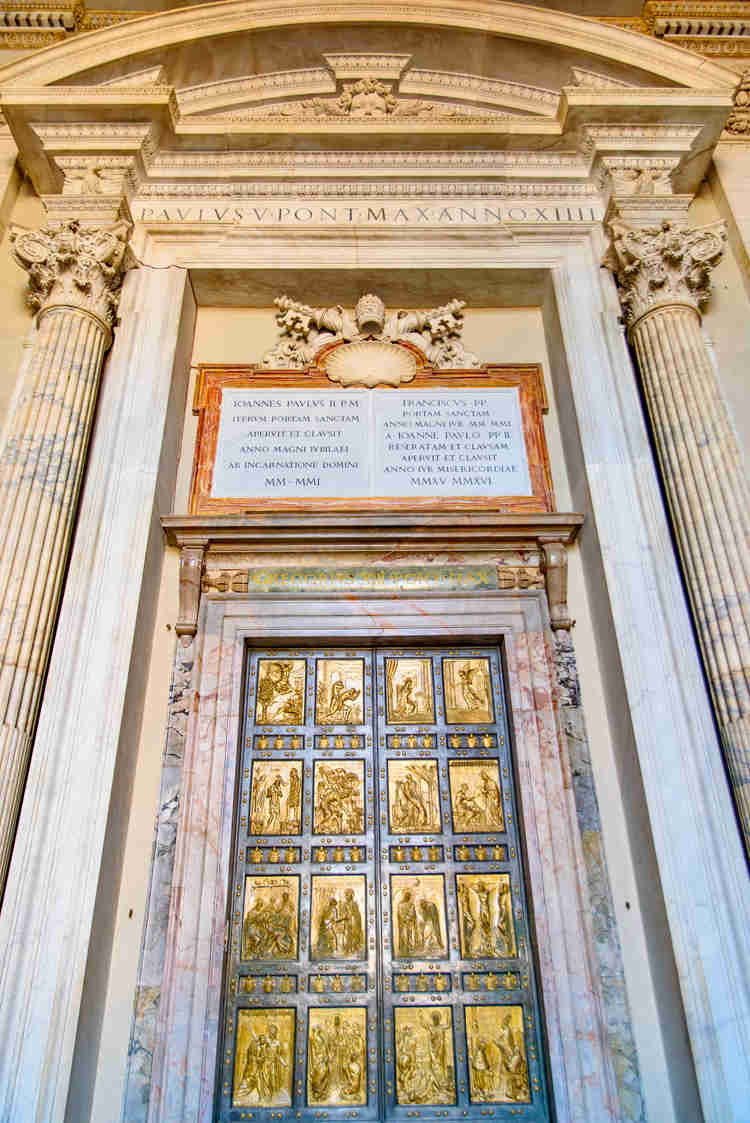
the Holy Door, only opened every 25 years
1. The Holy Door
The Holy Door is one of the three entrance ways into Saint Peter’s Basilica. It’s to the right of the main entrance to St. Peter’s.
The Holy Door is only open on a year that the pope deems a Holy Year, or Jubilee Year. During such a period, the Roman Catholic Church offers remission from the consequences of sin (under certain conditions). Holy Years are usually declared approximately every 25 years.
Behind the Holy Door is a concrete wall that is only removed in the Holy Year. The Holy Door will open next in 2025.
The doors illustrate the life of Christ in 16 bronze panels. The panels are divided by the coats of arms of popes who have celebrated Jublilee years.
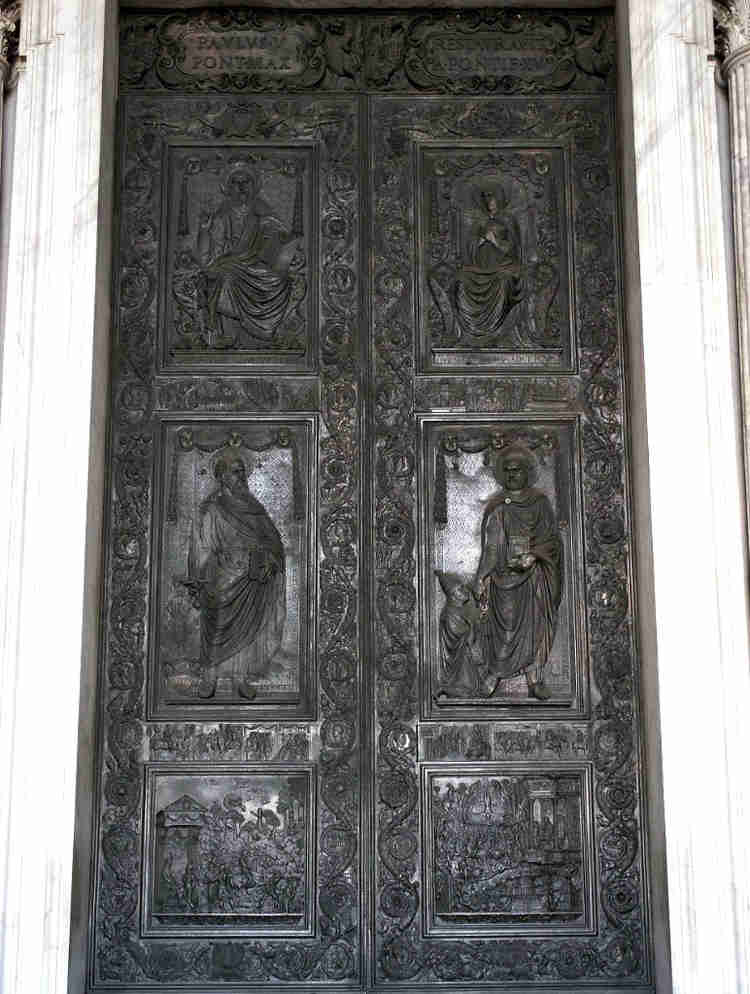
Filarete Door
2. Filarete Door
The basilica’s bronze entrance door was created by the sculptor Filarete and his workshop. It was salvaged from the Old St. Peter’s Basilica. The door was created during the early Renaissance between 1433-45.
The Filarete Door is completely covered with reliefs. The larger fields depict Christ, the Virgin Mary, St. Peter, and St. Paul. The narrow panels depict scenes from the life of Pope Eugene IV.
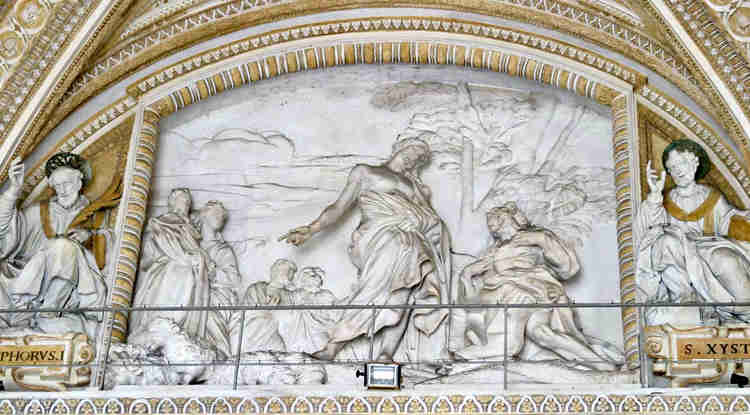
Bernini’s bas relief, Feed My Sheep
3. Bernini’s Feed My Sheep
Commissioned in 1633, Pasce Oves Meas (Feed my Sheep) is a monumental marble bas relief designed by Bernini. It was executed by his workshop, with some involvement of Bernini himself.
The relief represents Christ’s command to Saint Peter to “Feed my sheep.” The work is in the portico above the Filarete door of the basilica.
In the relief, Christ is shown giving the command to a kneeling Peter. He gestures toward his metaphorical “sheep.” Saints Peter and Paul watch the proceedings from the sidelines.
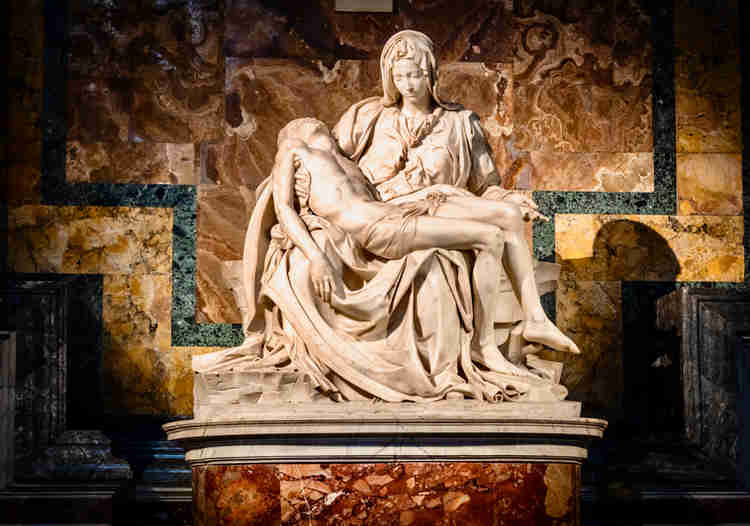
Michelangelo, Pieta,1498-1500
4. Michelangelo’s Pieta
Just to the right of the main entrance is Michelangelo’s Pieta behind bullet proof glass. It’s the most famous and popular thing to see inside St. Peter’s Basilica.
In 1497, Michelangelo was commissioned to create his iconic Pieta for a chapel in the Old St. Peter’s Basilica. The Pieta was then moved to the Chapel of the Pieta in the new basilica.
The Pieta was attacked by a mentally deranged geologist in 1972. After that fiasco, the Pieta was placed in lockdown behind bulletproof glass.
Behind the sculpture is a large cross, making it seem almost like an installation piece. I can’t say I think much of the color of the marble behind it either, a vomitous murky yellow.
The Pieta itself is tragically beautiful, a moving sculpture in which stone seems soft. And just look at Mary’s exquisite and grieving face … It’s quite a piece for a 23 year old. Michelangelo’s signature is across Mary’s sash. It’s the only work the artist ever signed.
After the Pieta’s resounding success, Michelangelo received the commission for what would become the world’s most famous statue, David.
READ: How To See Michelangleo’s David in Florence
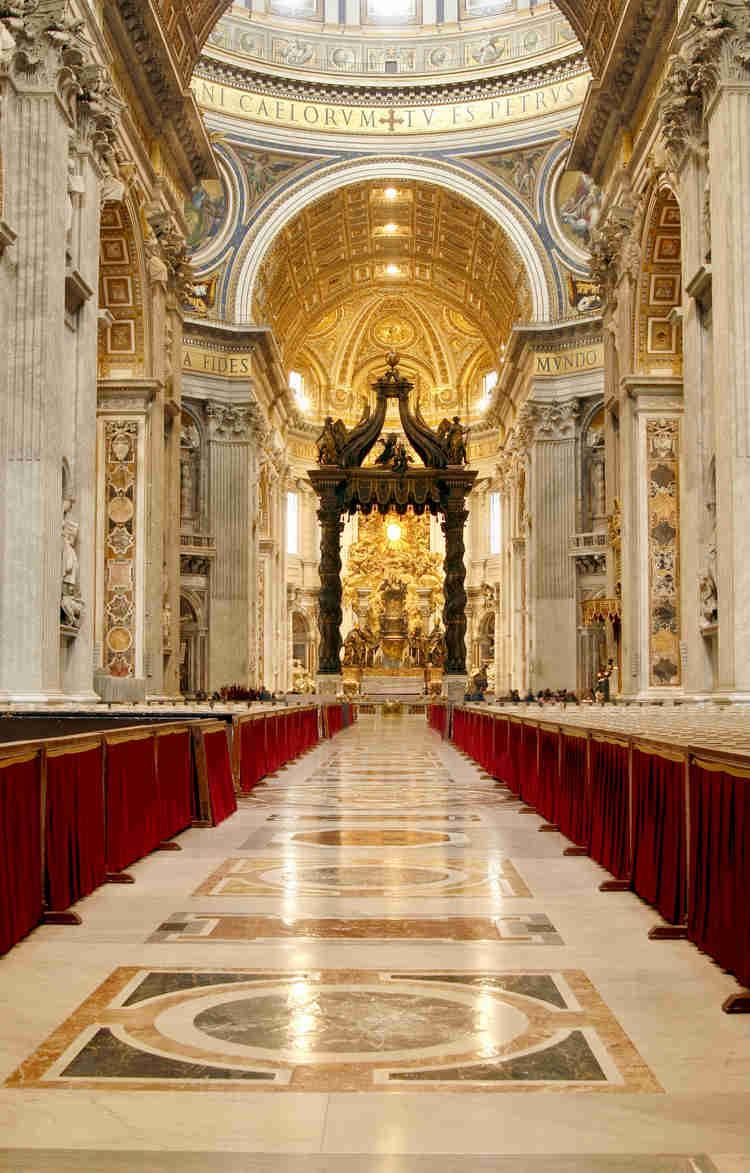
central nave of St. Peter’s Basilica
5. Central Nave
Maderno’s central nave is tremendously large, with a lot of glam and glitter. It’s 15,000 square meters and seats 20,000. The vault is supported by 800 columns. There are 45 altars and 450 monumental statues.
On the floor, you’ll see a series of circles. They indicate 15 smaller Christian churches. A red porphyry disc near the entrance marks the spot where Charlemagne and other emperor were crowned.
The wide nave has colorful stone floors, a barrel vaulted coffered ceiling, massive pillars, and gilded friezes. The decorations — cherubs, doves, and symbols of the papacy — were created by Bernini and his workshop.
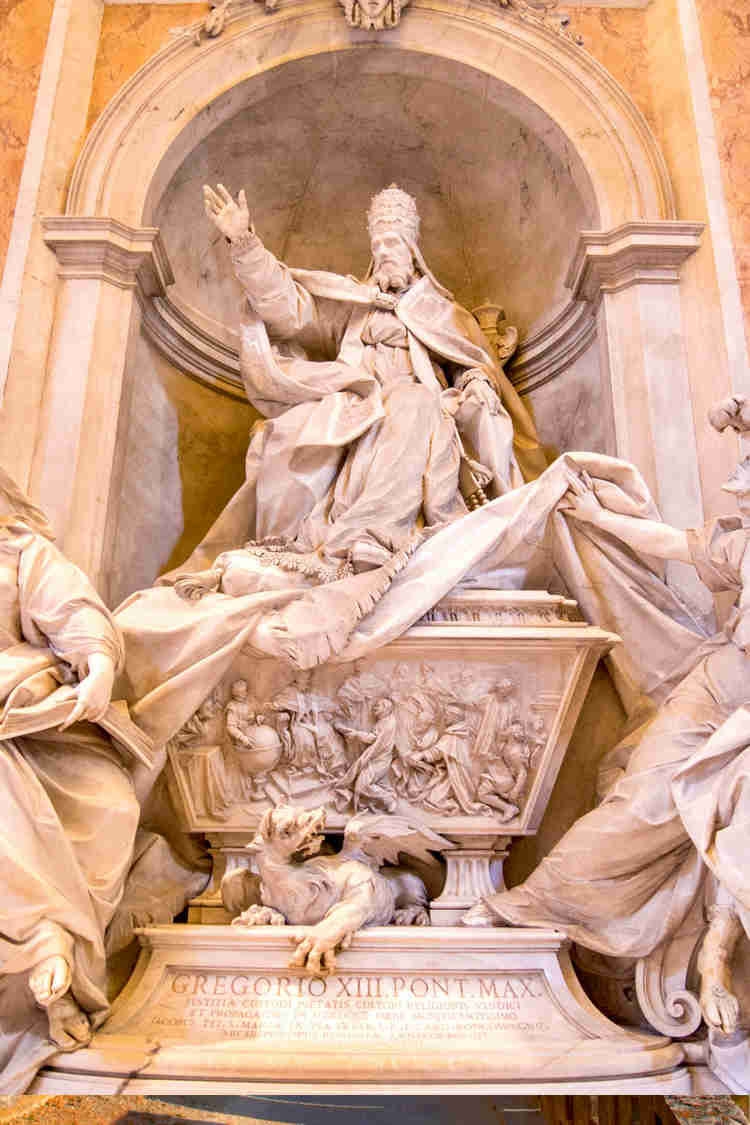
Bernini sculpture of Pope Urban VIII
6. Bernini Sculptures
Bernini was the greatest sculptor of the Baroque. He either carved or designed many of the works in St. Peter’s Basilica, including:
- Baldachin (1623-34)
- Tomb of Urban VIII (1647)
- Monument to Alexander VII (1672-78))
- Constantine on Horseback (1662-68)
- St. Longinus (1629)
- Chair of St. Peter (1640)
- Altar of the Santissimo Sacramento Chapel (1673-74)
- Tomb Monument to Countess Matilda (1633)
READ: Guide To the Bernini Trail in Rome
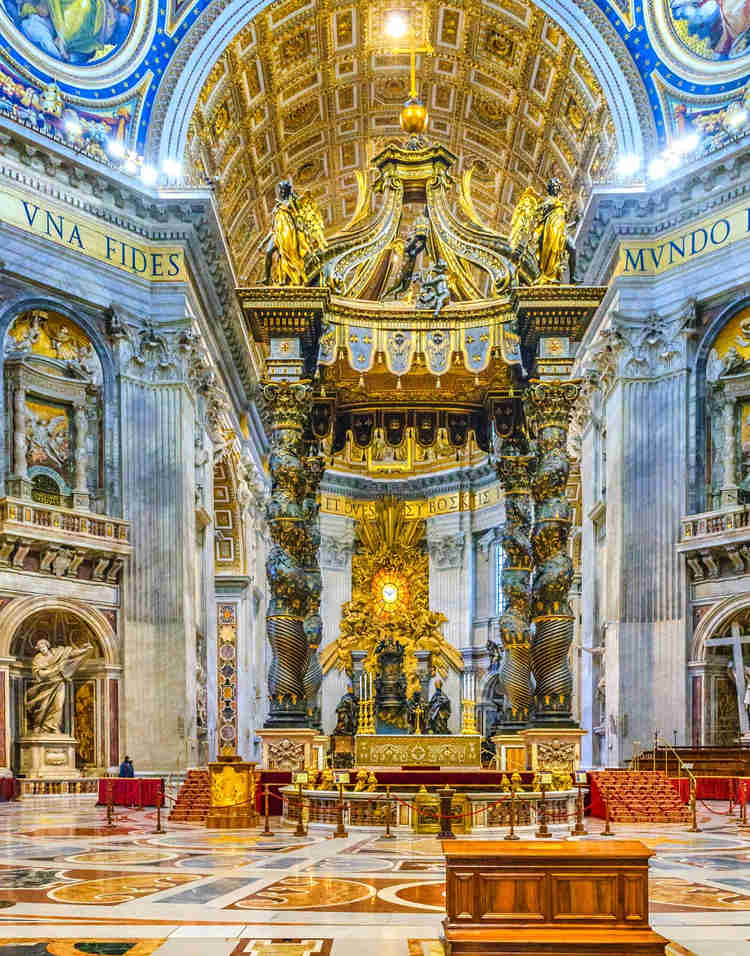
Bernini’s Baldachin
7. Bernini’s Baldachin
The Baldachin is the basilica’s most famous piece. In 1623, Urban VIII commissioned a young Bernini for the job.
After 10 years, the result was an elaborate and curvaceous bronze canopy covering the high altar at the central crossing. The Baldachin is there for one reason — to mark the spot where Saint Peter is buried. The only person who can preach mass from that spot is the pope himself.
The Baldachin is 98 feet tall, so that large that it’s the equivalent of a 10 story building. The 60 foot bronze columns are so dark they look like wood. At the top, there are four large angels in each corner. At the bottom are four golden pedestals.
The twisting Solomonic columns were inspired by an actual temple in Jerusalem. Decorative tassels hang off the cunningly draped “cloth” between the columns.
The structure was intended to suggest the vastness of god’s creation (and of the Barberini pope). To create the piece, Bernini recruited his father Pietro and brother Luigi to assist.
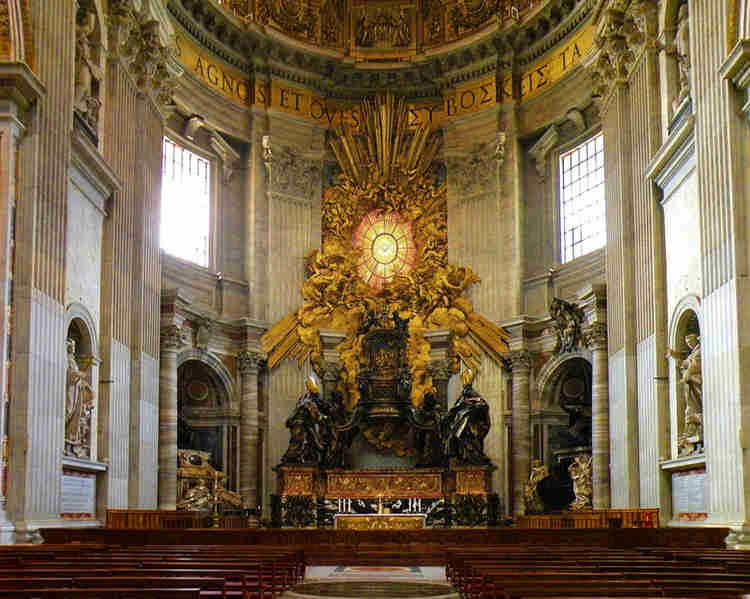
Chair of St. Peter
8. Throne of St. Peter | Cathedra Petri
The (rather overwrought) Chair of St. Peter is in the apse near the front of the basilica. Dating from 1657, Bernini’s theatrical and gilded sculpture glorifies the chair-throne as a symbol of the pope’s power and infallibility. Like a movie director, Bernini sets the chair within the frame of the Baldachin.
The bronze chair hovers and is received (but not supported) by four doctors of the church. The bronze chair encases the wooden one supposedly used by Peter himself, a treasured relic.
Above the chair is an oculus of amber light from yellow stained glass windows. It’s surrounded by cherubs and radiating rays of light. The white dove of peace (representing the holy spirit) is in the center. The papal tiara is held up by winged figures.
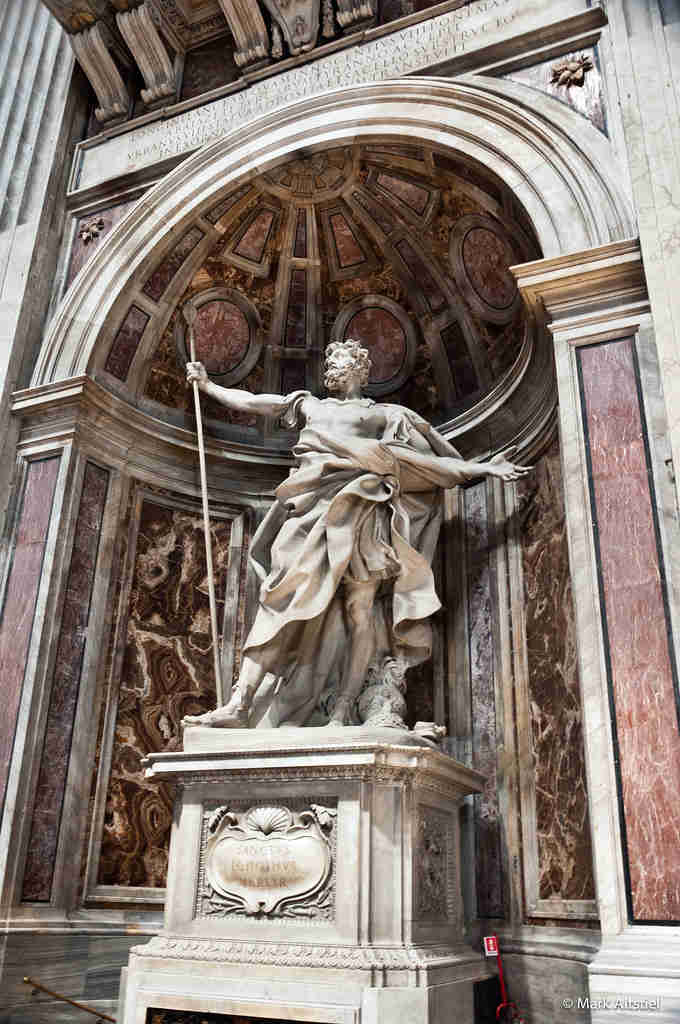
Bernini’s St. Longinus
9. Statue of St. Longinus
According to legend, St. Longinus was the soldier who pierced the side of Christ while he was on the cross. Longinus then declared Christ’s divinity. Longinus later died a martyr’s death and was greatly revered by the church.
Bernini sculpted the colossal marble statue of Longinus between 1628-38. Like Bernini’s sculptures in the Borghese Gallery, the saint is in action, standing in a contrapposo position with outspread arms.
READ: Complete Guide To the Borghese Gallery
In his right hand, Longinus holds his attribute — the holy spear. He has an ecstatic upward gaze. It’s one of the only statues in the basilica that receives natural light.
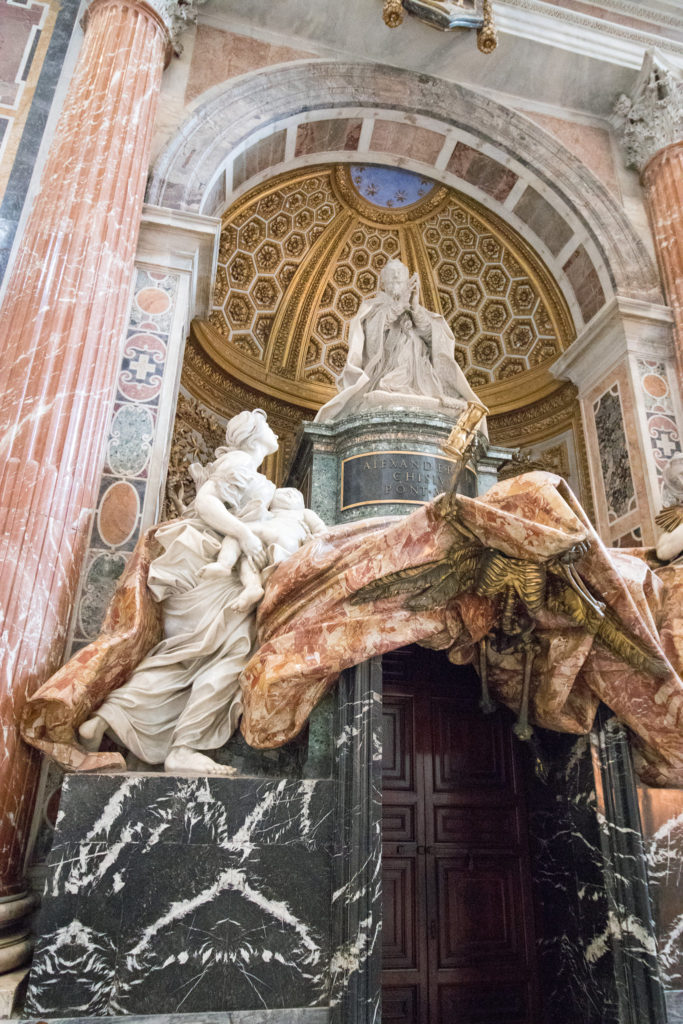
Tomb of Alexander VII
10. Tomb of Alexander VII
This is a beautiful Bernini sculpture. Completed in 1678, Bernini was 80 years old. He basically supervised the actual work. Although he may have sculpted Alexander’s face and hands.
In the tomb sculpture, Alexander kneels in prayer. Below him are four allegorical female figures embodying the virtues of Charity, Prudence, Justice and Truth. The pope and the virtues are in white marble. Everything else is intricately colored.
Stone drapery covers the strange figure of death. A bronze skeleton eerily raises an hourglass to symbolize the passage of time.
Bronze Statue of St. Peter
11. Bronze Statue of St. Peter
This bronze sculpture of St. Peter was created by the great 13th century Florentine sculptor and architect Arnolfo di Cambio. Arnolfo is famous as the first architect of Florence’s Duomo.
READ: Guide to Florence’s Duomo and Brunelleschi’s Dome
The statue was salvaged from the old basilica. Peter’s polished foot is proof that hes highly revered by visitors, who show their devotion by rubbing or kissing his toes.
Peter, the Prince of the Apostles, sits on a marble chair. With his left hand, he holds the keys of Heaven (his attribute). He gives a blessing with his right.
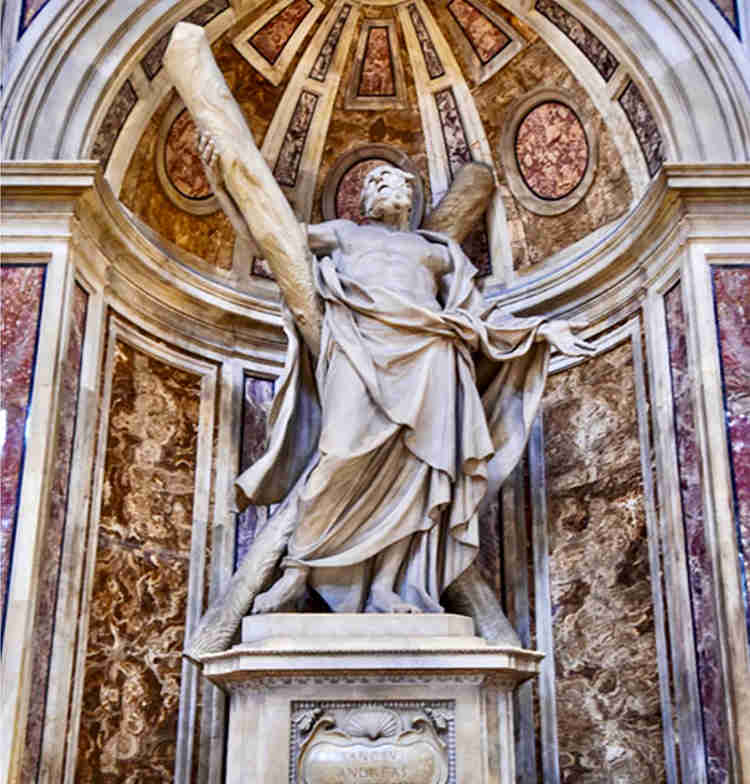
Statue of St. Andrew
12. Statue of St. Andrew
This statue by Francois Duquesnoy, a Flemish baroque sculpture, was created for one of the basilica’s niches. It’s one of the four central monumental statues that frame the Baldachin, along with Saint Longinus, Saint Helena, and Saint Veronica.
Saint Andrew was an apostle and the brother of Saint Peter. He was martyred by crucifixion in the city of Patras Greece. Early texts report that he was bound, not nailed, to a cross.
The iconography of showing Andrew bound to a cross stuck and was a standard image of the Middle Ages. In fact, this statue is routinely called Saint Andrew’s Cross. In it, Andrew head and arms are arranged in a theatrical way akin to Bernini’s St. Longinus.
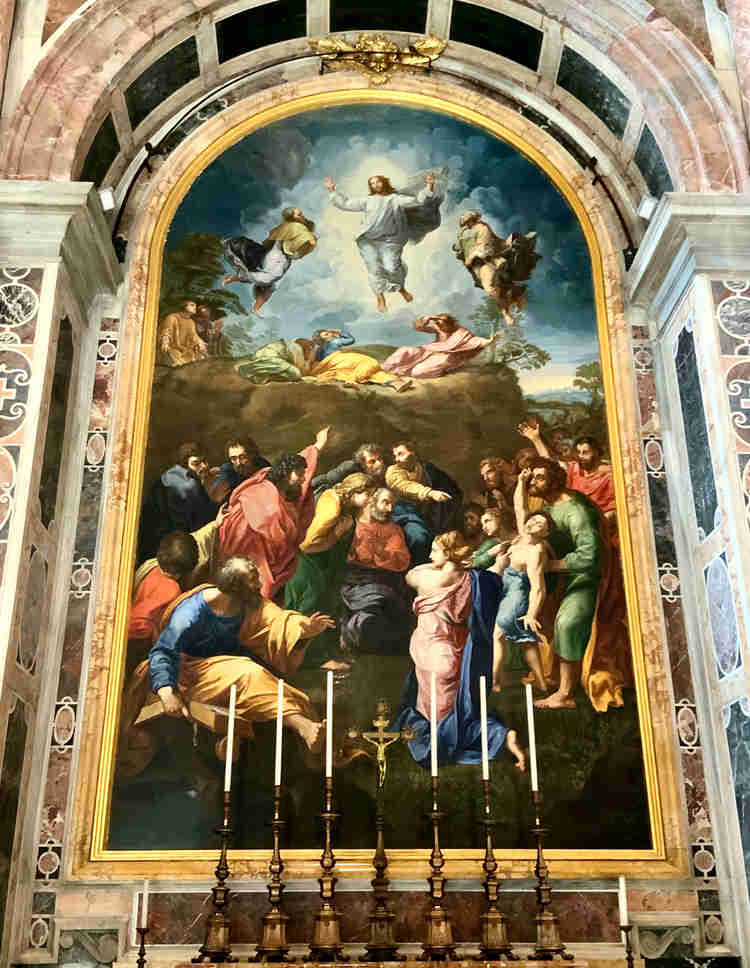
Mosaic of Raphael’s Transformation
13. Mosaic of Raphael’s Transformation
The original of the beautiful Transfiguration is now in the Vatican Pinacoteca. It was painted by Raphael, one of the greatest painters of the Renaissance period.
The Transfiguration was commissioned by Cardinal Guilio de Medici, who later became Pope Clement VII. The painting combined two biblical narratives.
It tells the story of Christ leading his disciples up a mountain to show them his true form, a being of pure light. It also depicts a miracle — when Christ exorcized the demons of a young boy suffering from lunacy.
The Transfiguration is important because it bridges the period between the high Renaissance and the Baroque. It’s notable for its use of chiaroscuro (the effect of contrasted light and shadow), skill in composition, and expressiveness.
If you don’t make it to the Pinacoteca, there’s a beautiful mosaic copy of The Transfiguration in St. Peter’s Basilica. It was created by Stefano Pozzi.
In the 17th century, all the basilica’s original paintings were removed to the Vatican Pinacoteca (art gallery) and replaced with mosaics.
Giotto’s mosaic of the Navicella
14. Giotto Mosaic of the Navicella
Giotto’s Navicella mosaic is found in the portico of the basilica, facing the entrance to the church. Cardinal Stefaneschi commissioned the great Florentine painter to create the mosaic.
The mosaic likely dates to the late 13th or early 14th century. It was formerly in the entrance arcade of the old basilica and moved to the new one in 1610.
Navicella means little ship. The mosaic depicts the stormy scene from Matthew 14:22-14:23. Christ grabs Saint Peter by the hand, just as he is about to go under. Peter walks on water toward Christ. The message is that, when life gets stormy, trust in your faith.
Unfortunately what you see isn’t really original. The mosaic has been altered and restored on many occasions, mostly in the seventeenth century. It was partially destroyed and reconstructed during the demolition of the old basilica.
Tomb of Saint John Paul II
15. Tomb of Saint John Paul II
The tomb of Saint John Paul II lies under the mosaic of the Altar of St. Sebastian, originally painted by Domenichin. The tomb is the most popular place of pilgrimage within the Vatican.
John Paul was the second longest serving pope, working from October 16, 1978 until April 2, 2005. John Paul was canonized by Pope Francis on April 27, 2014.
His original resting place was in the Vatican Grottoes beneath the basilica. But his remains were transferred up to the basilica itself in 2011. It’s housed in the Chapel of St. Sebastian, located just off the central nave.
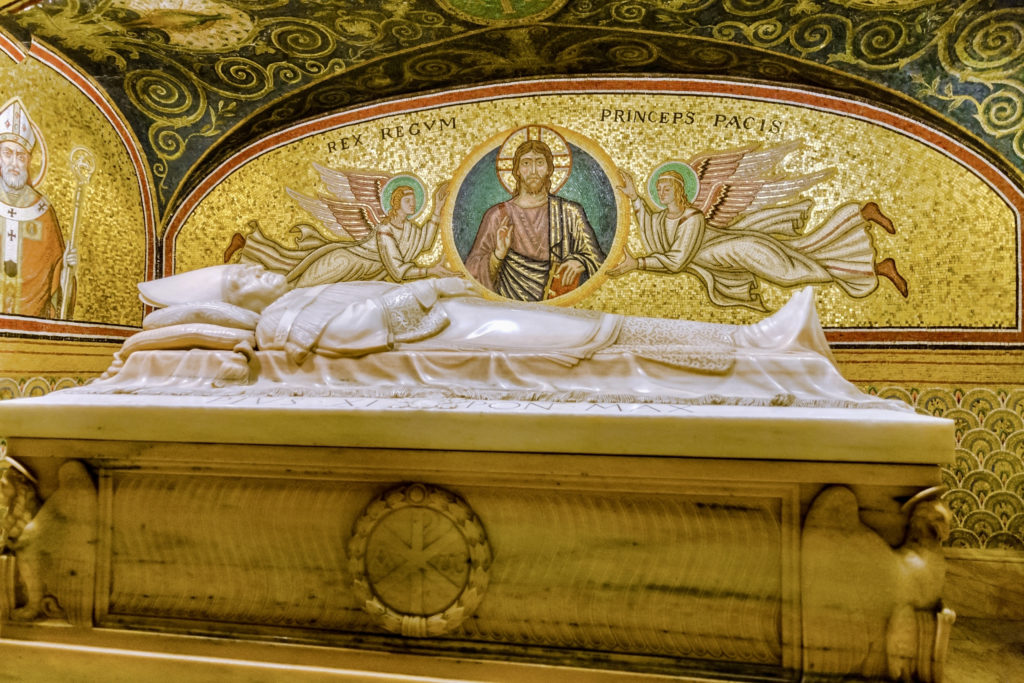
16. Grottos
The Vatican Grottos are the vast underground graveyard below St. Peter’s Basilica. The entrance is at the transept of St. Peter’s Basilica near the elevator kiosks for the dome. You can visit the grottos for free.
The grottos are the burial place of 91 popes and some other church dignitaries such as cardinals, dating from the 10th century and onward. In addition the grottoes also include some tombs of secular monarchs.
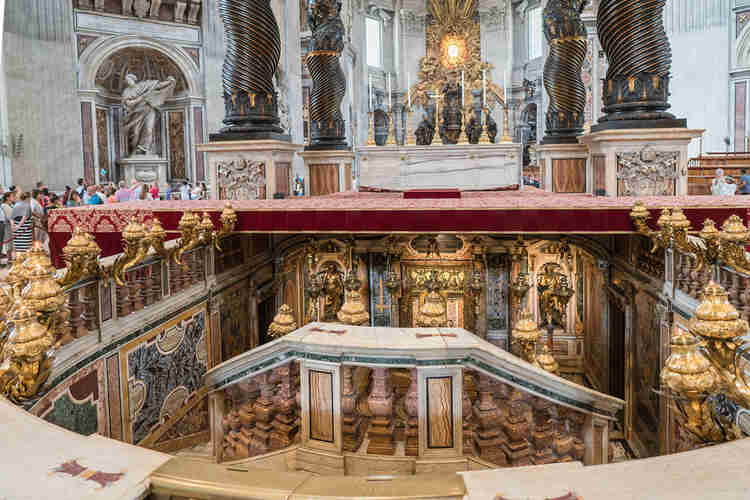
view of St. Peter’s Tomb
17. St. Peter’s Tomb & Necropolis
St. Peter was crucified and buried in 64 A.D. He was crucified upside down so as not to be equated with Jesus. The story goes that Peter lost his life in a wave of anti-Christian persecution under Emperor Nero.
Christians were worried that someone would steal Saint Peter’s body. They hastily chopped his body off the cross, leaving his feet there. The rest of St. Peter’s body was buried in a nearby necropolis.
A fun fact is that Peter’s name was really Simon. He was given the name Kepha or Cephas meaning “rock” by Jesus.
In Greek, this translated to “Petros” from Petra, hence where the name Peter came from in English. You may recall the Biblical verse in Matthew 16 where Jesus says “on this rock I will build my church.”
READ: Visiting Mamertine Prison (where Peter was imprisoned)
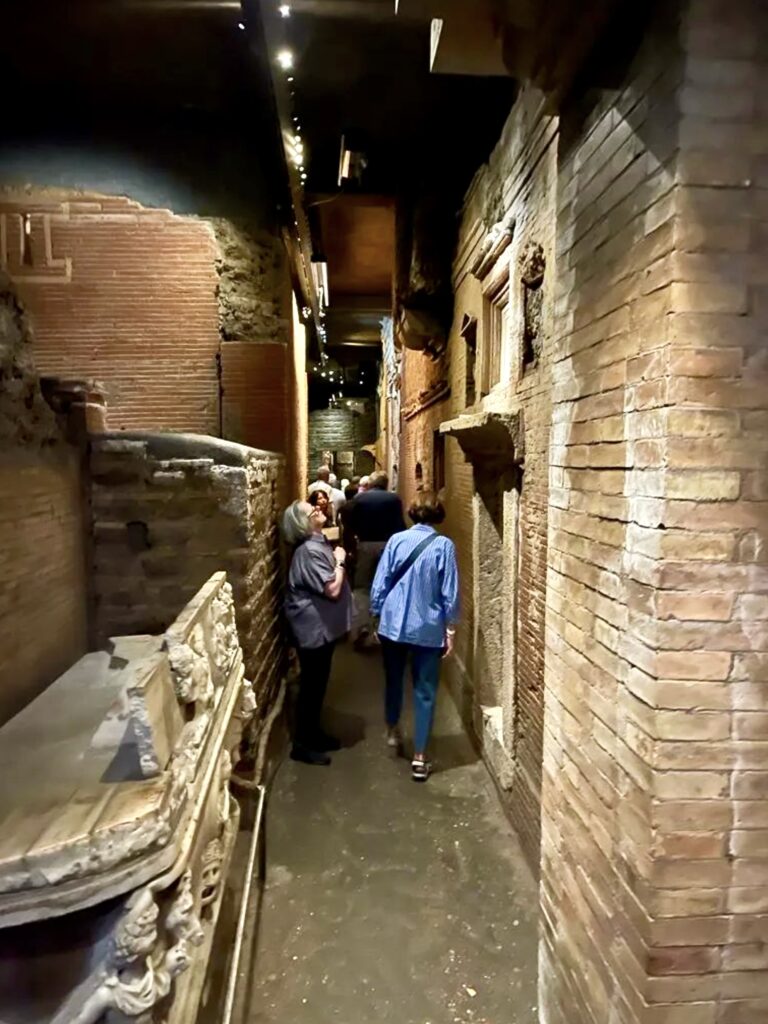
Over centuries of time, the necropolis became buried. For awhile, noone knew where St. Peter’s body was located. In the 1930s and 1940s, Pope Pius the XII ordered excavations to look for St. Peter.
Initially, archaeologists reached a dead end. But eventually experts figured out where to look. They found a tomb set apart from all the others.
Inside, they found the remains of a senior adult male of burly stature, matching the description of Saint Peter. The real proof? The skeleton’s feet were missing.
You will also see tombs from the Roman era and ancient graffiti and inscriptions made by early Christians.
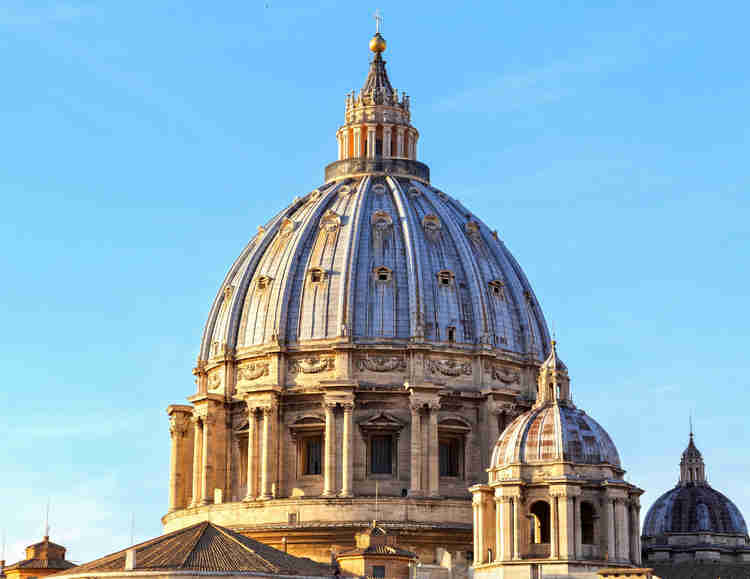
St. Peter’s dome
18. St. Peter’s Dome
In 1546, Michelangelo was hired to design St. Peter’s dome. It was only partially completed at his death. The hemispherical interior follows Michelangelo’s designs.
The construction of the dome was completed by Giacomo Della Porta and Domenico Fontana in 1590. They substituted an elegant “melon” dome for a hemispherical dome on the exterior. Above the windows, the dome is divided by 16 ribs.
The dome rests on a tambour, a cylinder of stone fronted by colossal Corinthian columns. The columns serve the same purpose as flying buttresses, counteracting the outward thrust of the dome.
The dome is topped by a 55 foot lantern and beautiful golden globe with a cross, similar to the one on the Baldachin. St. Peter’s beautiful dome inspired domes like that of Les Invalides in Paris.
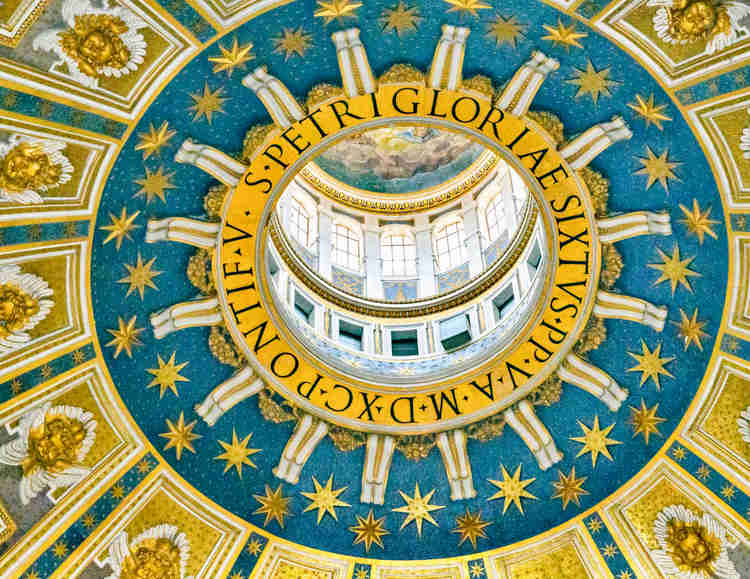
detail of the cupola
19. Climbing the Dome
The dome rises right above the Baldachin. The interior is beautifully decorated with glittering golden mosaics. They were added in the late 16th century by renowned artists such as Cesare Nebbia, Paolo Rossetti, Giovanni de’ Vecchi and the Cavalier d’Arpino.
The mosaics are divided into six concentric rings. The rings depict the popes, saints, apostles, angles, etc.
The entrance to climb the dome is at the portico of the Basilica. For just € 6, you can climb up a narrow spiraling flight of stairs to inspect the cupola at close range. There’s also an elevator for € 8.
view of the cupola
Halfway up, you’ll have a bird’s eye view of the mosaics and the nave below. You can also walk out onto the roof of the basilica and check out the statues of Christ and the apostles (seen from the back).
Continue 320 steps higher to stand on the outside of the dome. It’s a claustrophobic ascent.
This is where you have the iconic view of St. Peter’s Square and a panoramic view of Rome. The best time to photograph this spot is near closing time, when the sun is behind the basilica.
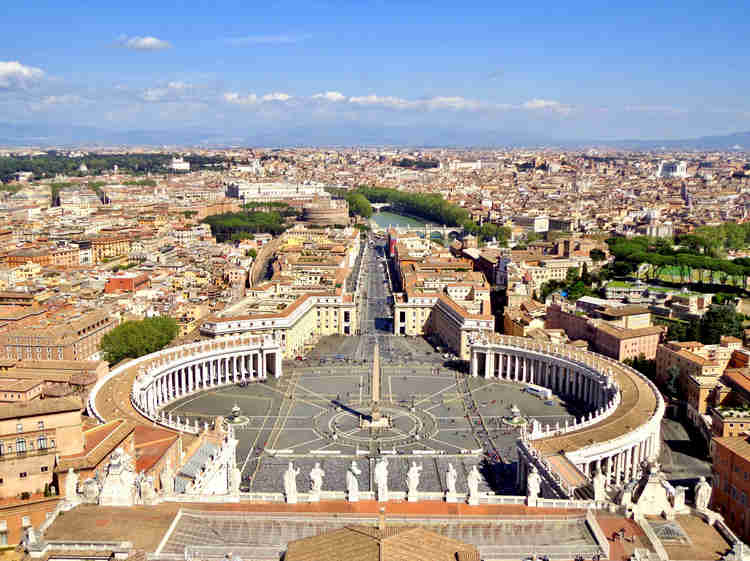
view of St. Peter’s Square from the dome
20. St. Peter’s Square
In 1656, Pope Alexander VII commissioned Bernini to build a vast square worthy of St. Peter’s Basilica. Prior to hiring Bernini, the piazza was an empty space with a lone obelisk. Bernini created an elliptical plaza with two semi circular colonnades, consisting of four rows of Doric columns.
The colonnades represent a pair of stretched and embracing arms, welcoming pilgrims to the basilica. If you stand on the foci (marble plates) near the fountain designed by Maderno, the columns line up perfectly behind one another.
On the balustrade at the top of the columns are a line of 140 statues of saints, martyrs, and popes crafted by Bernini’s workshop. At the center is is an Egyptian obelisk brought to Rome by Caligula around 37 A.D.
The paving stones of the square are cobblestone and travertine marble. They radiate from the central hub of the obelisk. The square is a magnificent entry point to the basilica, meant to be a symbolic heaven.
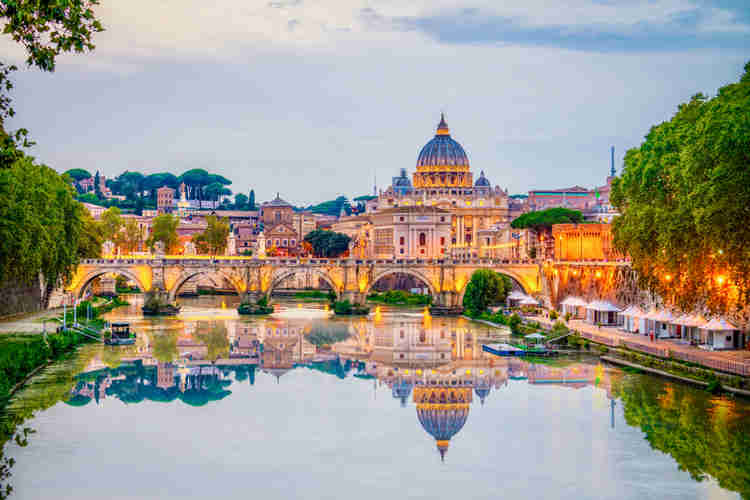
Practical Guide & Tips for Visiting St. Peter’s Basilica
Address: Viale Vaticano 00165 Rome
Hours:
The basilica is open daily 7:00 am to 7:00 pm, closing at 6:00 pm in winter. Be aware that, on Wednesdays when the Pope holds his audience in St. Peter’s Square, the Basilica doesn’t open until 12:00-1:00 pm.
Entrance: If you’re already in the Vatican Museums, you can enter St. Peter’s Basilica from the Sistine Chapel.
Entry fee: Free, but you’ll have to line up and go through security. Audio guides can be rented at the entrance of the Basilica.
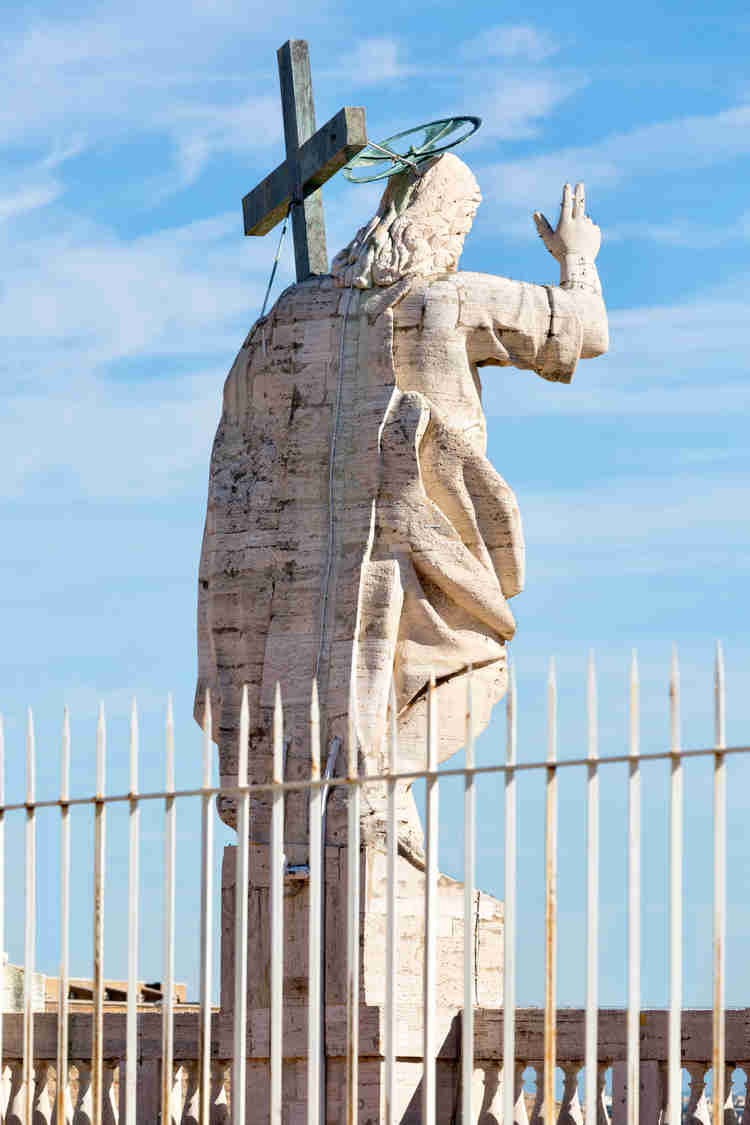
statue of Jesus you can see while climbing the dome
Dome Entry Fee and Hours
The entrance to the dome is on the right side of the basilica, above the visitor center. The dome is open daily from 8:00 am to 5:00 pm, until 6:00 pm during high season from April 1 to September 30.
A ticket costs € 6 euros if you climb the 551 steps or € 8 to take the elevator midway up. You can also book a guided tour of the basilica that includes a dome climb.
From the elevator, it’s another 320 steps to the top. Allow about an hour for the experience.
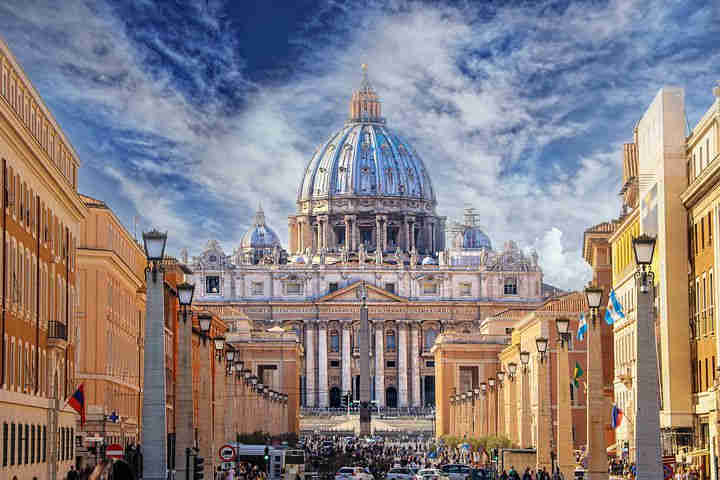
Treasury: Open from 09:00 – 18:15, April to September and from 09:00 – 17:15, October to March. €5 to enter.
How Best To Visit St. Peter’s Basilica
Here’s my recommendation for the best way to visit St. Peter’s Basilica. Enter the basilica, look around to get a feel for its grandeur and magnificent statuary.
Head down to the papal tombs in the grotto. The exit will take you back outside where you’ll find the ticket office for the dome.
Climb up the dome and enjoy the views. Climb back down and enter back into the basilica. Then, with your audio guide, you can soak in all the wonders inside.
There’s no entry fee, but you have to go through security to get into the basilica. There are almost always long lines. These queues tend to move along fairly swiftly, so don’t be too put off by the masses of tourists.
If you want to avoid them, it’s best to shown up bright and early at 7:00 am. Of course, if you access the basilica as part of a Vatican Museums visit, there won’t be a line either.
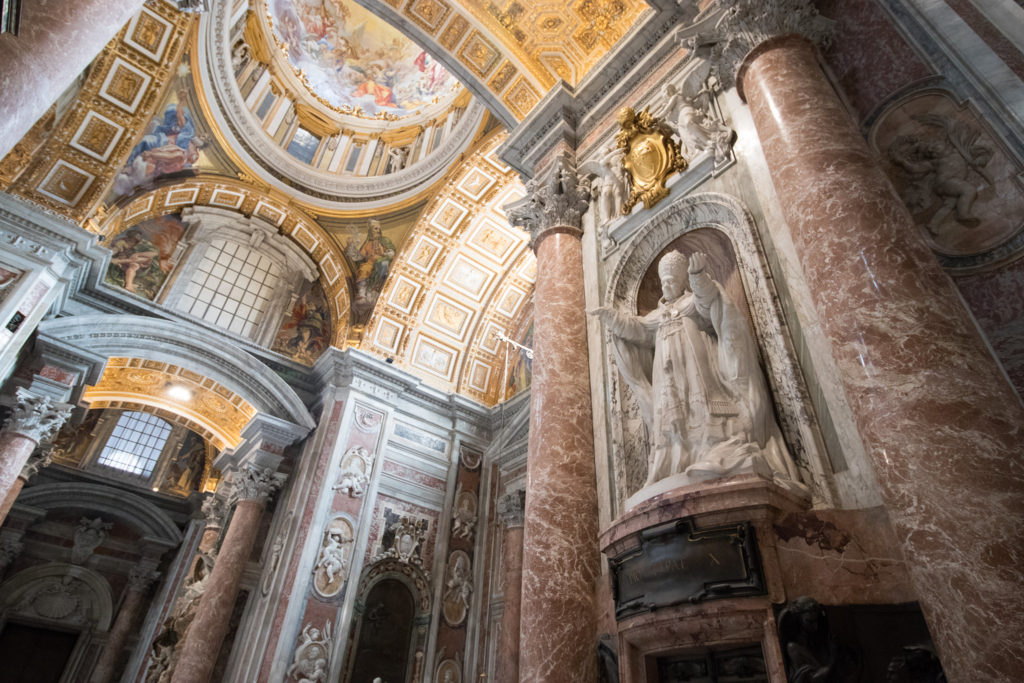
How To Visit St. Peter’s Tomb
It’s rather difficult to visit St. Peter’s tomb. Only 250 people are allowed in daily in small groups of 12.
You have to go through an application action process and sign up for the Scavi tour. Click here for the Vatican’s official Scavi website.
Two months before your visit, you will need to send a fax or email, providing information on your visit and the date range you’ll be in Rome.
Then, you just wait for them to get back to you. Once they do, you will need to prepay for the tour (13 €). Show up 10 minutes early.
If you can’t get in, you might consider a visit to Mamertine Prison. You can see the cell where St. Peter was held before his execution.
I hope you’ve enjoyed my guide to visiting St. Peter’s Basilica. You may enjoy these other Rome travel guides and resources:
- 8 one day in Rome itineraries
- 3 day itinerary for Rome
- 5 day itinerary for Rome
- Itinerary for central Rome
- Hidden gems in Rome
- Best museums in Rome
- Archaeological sites in Rome
- Masterpieces of the Vatican
- Guide to Palatine Hill
- Guide to the Roman Forum
- Guide to the Colosseum
If you’d like to visit St. Peter’s Basilica in Rome, pin it for later.

